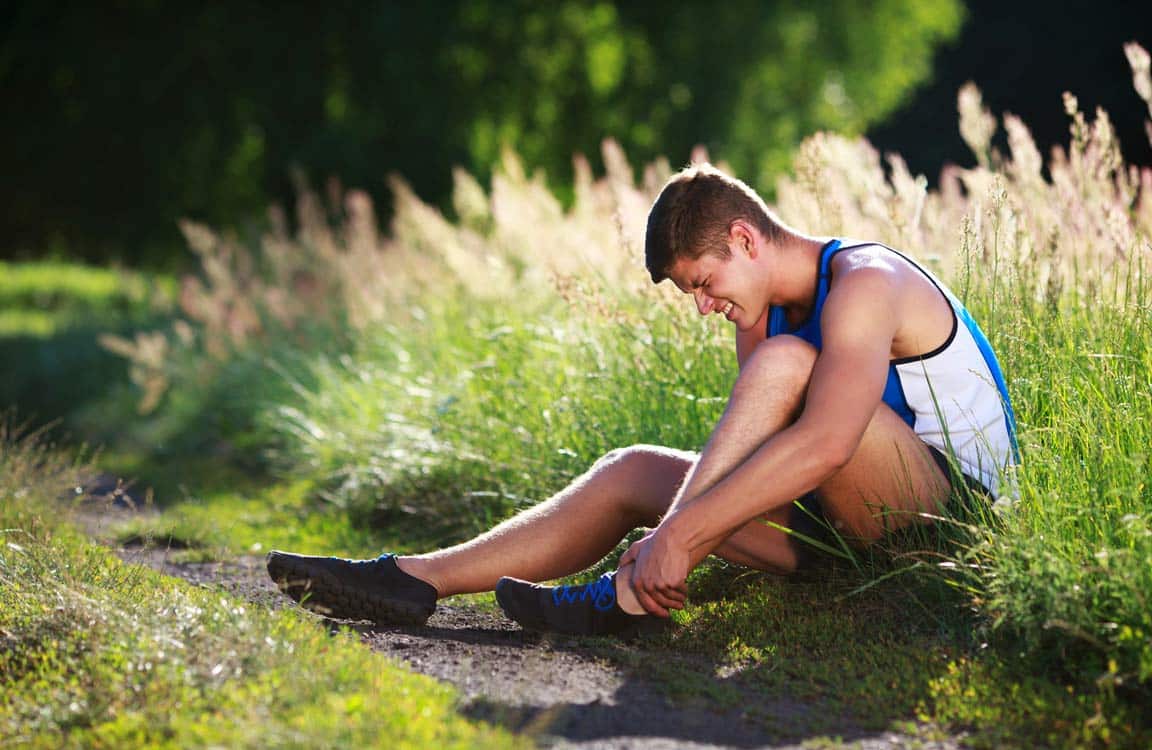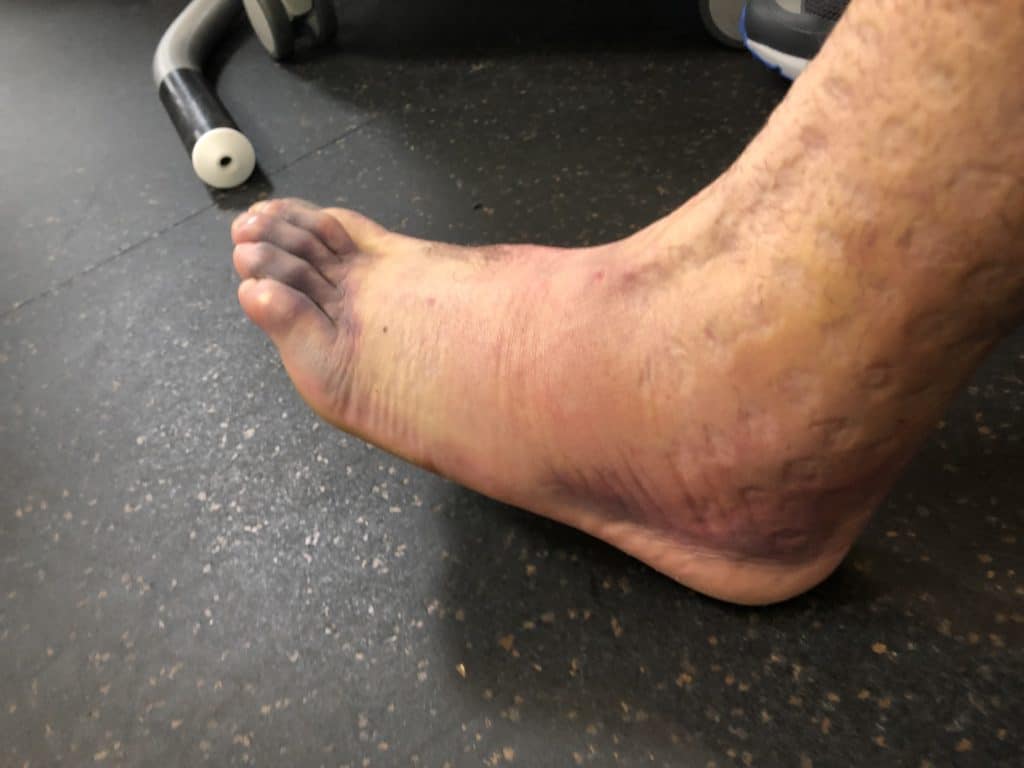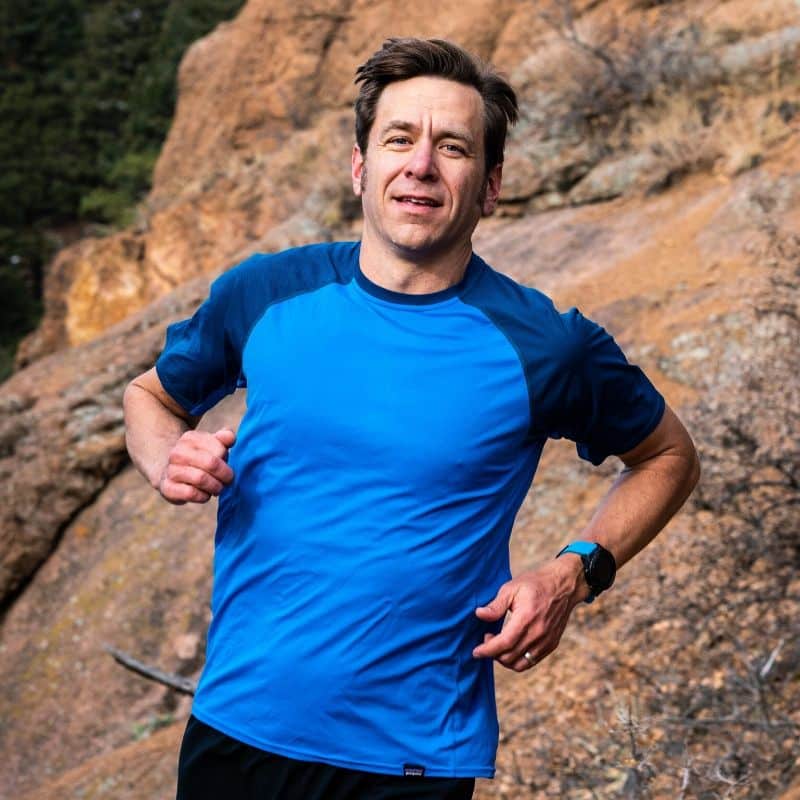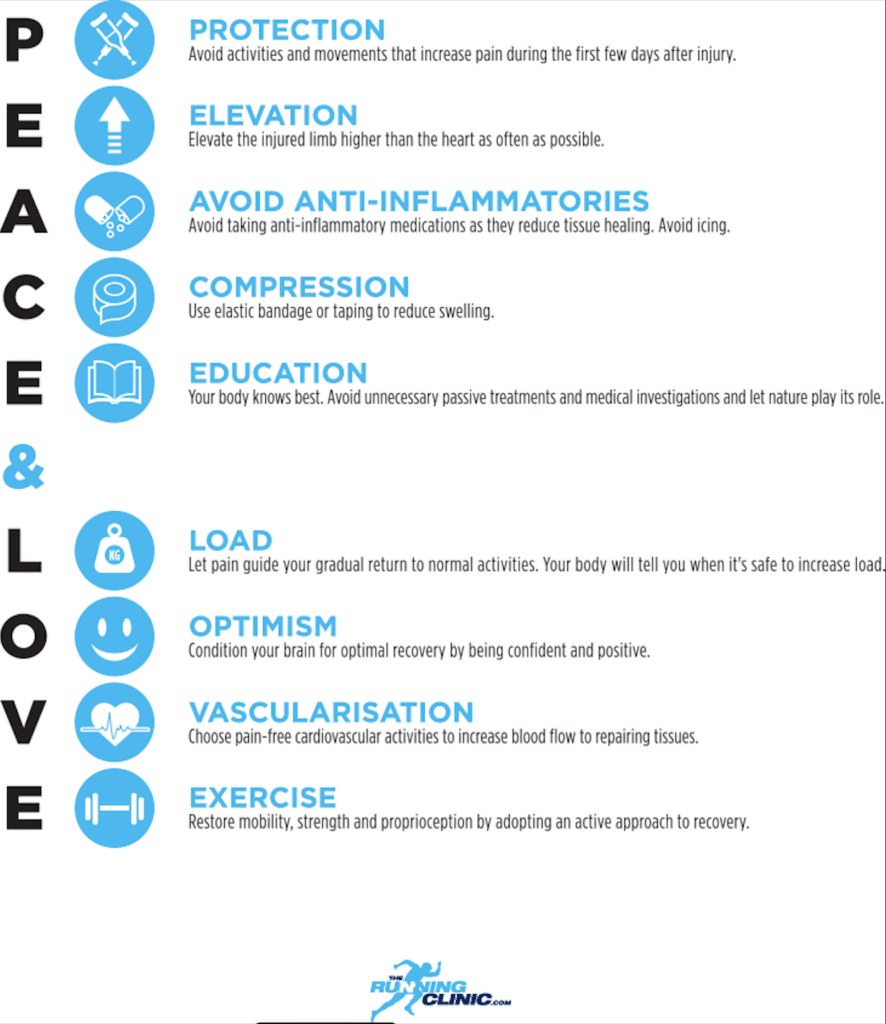
Give Your Running Injuries Some PEACE and LOVE
By Jason Koop,
Head Coach of CTS Ultrarunning
One of the more audacious coaching goals I made for myself this year was to have less than a third of my athletes miss a training day due to injury. I knew this was a lofty goal as, depending on what research you read, up to 80% of runners will sustain an injury at some point. This goal was well on track for the first part of the year, and I took a bit of pride knowing my athletes were handling their training loads well. However, it all got derailed when I received the following four messages, from four different athletes, all in quick succession:
“I rolled my ankle bad today, headed to get an x-ray. X-ray confirms an avulsion fracture. F*%k.”
“I took a really bad fall and slammed my knee into a rock. It’s swollen and I can’t bend it.”
“I was just in a bad car accident. My right leg is pretty banged up.”
“I rolled my ankle on the trails today. It’s swollen and purple”.

Ouch! Not the image I was hoping to see from Dylan Bowman…
What do all of these have in common? They are freak accidents. Also, although they are not classified as a stereotypical overuse injury, each of the above will still impact training.
Caring for injuries is an inevitability for any endurance athlete. Oftentimes these injuries come in the form of some random ankle roll or stumble (as in the examples above). Others are classic overuse injuries like tendonitis, a strain, or even a stress fracture (which I was trying to avoid with my coaching goal this year). In any case, the better you handle any injury, the better your return to running.
With the above constellation of injuries in the forefront of my brain, a recent (and timely) blog in the British Journal of Sports Medicine caught my attention. In it, the authors propose new acronyms for treating and rehabilitating injures. Many athletes are familiar with the now outdated acronym RICE, which stands for Rest Ice Compression Elevation. Rightfully so, RICE eventually evolved to PRICE (Protection Rest Ice Compression Elevation) and then finally to POLICE (Protection Optimum Loading Ice Compression Elevation). Now, as the authors in the BJSM are suggesting, a combination of acronyms should be used to address both the acute phase of the injury as well as the continuum of care needed. You can access the entire blog here.
The authors suggest a new, two-part acronym to treat soft tissue injuries: PEACE and LOVE
PEACE: Protect, Elevate, Avoid anti-inflammatories, Compress, Educate
LOVE: Load, Optimism, Vascularisation, Exercise.
Yes, the acronyms are getting longer. Yes, you can bust out the tie die and flower power! All joking aside, I think it’s a brilliant acronym for how to treat an injury, as well as how to treat yourself during the injury process.
► Free Ultrarunning Training Assessment Quiz
Take our free 2-minute quiz to discover how effective your training is and get recommendations for how you can improve.
Intentionally, the two individual acronyms represent what athletes should do in the immediate hours and days after a soft tissue injury (PEACE) and then what to do after the first few critical days (LOVE). Rather than simply regurgitate what you can read on your own (we’re all adults, it will take you fewer than 3 minutes to read), I would like to point out what’s significant about the suggestions and what they mean for ultrarunners.
Continuum of care
Above all else, if you take one thing away from PEACE and LOVE it is that you need to care for both the acute injury and (this is a newer part of the recommendation) take physical and psychological steps for the long term. Previous suggestions and their associated acronyms were almost entirely focused on the physical and immediate actions to take (reduce swelling, protect the injured tissue, etc.). We’ve since realized that injury care should extend beyond the initial, and often traumatic, physical phase. Care should also encompass medium-term rehabilitation as well as the injured athlete’s psyche and emotions (more on that later). Bottom line, if you get banged up, immediately fix what’s broken and then work on the longer process of getting well.
Get rid of the anti-inflammatory modalities, including NSAIDs
Full disclosure: I at times fully abused Ibuprofen (or as I lovingly called it, Vitamin-I) and ice in my 20’s. As an oft-injured runner, I’d pop a few Ibuprofen at least once a week to manage the little niggles that are inevitable from running in any collegiate program. I was even worse with ice. Just about every hard workout ended with some sort of ice bag, ice bath or cooling pack on aching muscles and joints. Little did I know, these actions were actually inhibiting healing.
The authors call for avoiding such anti-inflammatory modalities, as they impair tissue healing. Ultrarunners should take note. If you roll your ankle or have some sort of other soft tissue injury, skip the drugs and the ice and you will be better off.
Educate yourself, fool
Everyone knows someone who needs their acupuncturist, massage therapist, foam roller, or –the newest toy on the block – their percussive therapy device. Their religious (word chosen with intent) and Pavlovian response to hard workouts or injuries is turning to a device or dialing up their favorite practitioner. A few of these recovery modalities have their time, place and use case. These should be used when the need for them comes around.
Enjoying This Article? Get More Free Running Training Tips
Get our coaches' best training advice, delivered straight to your inbox weekly.
A small handful are actually counterproductive, making an injury worse, and should be avoided. However, most of the modalities are simply benign – they neither hurt nor help. On the surface, there is nothing wrong with using one of these techniques as long it makes you feel better and it’s not counterproductive. We’ve all heard the phrase, “If it can’t hurt, might as well do it”, in this setting. But, the authors argue that the real problem with this mentality is that it creates dependency and a ‘need to be fixed’, leading athletes to feel athletes they are constantly in some state of brokenness.
I see this in athletes and on social media constantly: “My acupuncturist/massage therapist/TheraGun is a miracle worker!” No, they are not. The only miracle in sports was the 1980 US Ice Hockey team, right? So, take some time and learn what cupping and your newly polished TheraGun do and don’t do, or what that foam roller actually does and does not do. Use the right tools, therapists and modalities for the job.
Mind Matters
At times, injured athletes can feel hopeless. You can’t see the light at the end of the tunnel and your hard earned fitness feels like it is running away faster than Killian Jornet going down the Matterhorn. Yet, research is showing us more and more that when you are injured, your outlook impacts your recovery prospects. As the authors note, “Psychological factors such as catastrophisation, depression and fear can represent barriers to recovery.” Basically, if you feel like your injury is going to last forever, it probably will. You can help the process by staying optimistic and not blowing things out of proportion.
Summary
Ultrarunners are going to get banged up. It’s a hazardous sport and for the vast majority, it’s just a matter of when, not if, you are going to get injured and have to sit on the sidelines. When the time comes, give yourself and your injury some PEACE and LOVE. Treat the injury immediately and then settle in for the long haul.



Comments 3
Pingback: Trail Running Daily News | Friday, May 24 - Yeovil Marathon
Pingback: Trail Running Daily News | Friday, May 24 | Ultrarunnerpodcast.com
Great article!
I dare to object, though. In my opinion, ankle rolls are not “freak accidents”. Maybe in a way, yes, but they are most likely the result of things like general fatigue, nervous system fatigue, a lack of coordination, insufficient ability to balance, muscle weakness, weak ligaments due to a previous ankle injury … something along this line.